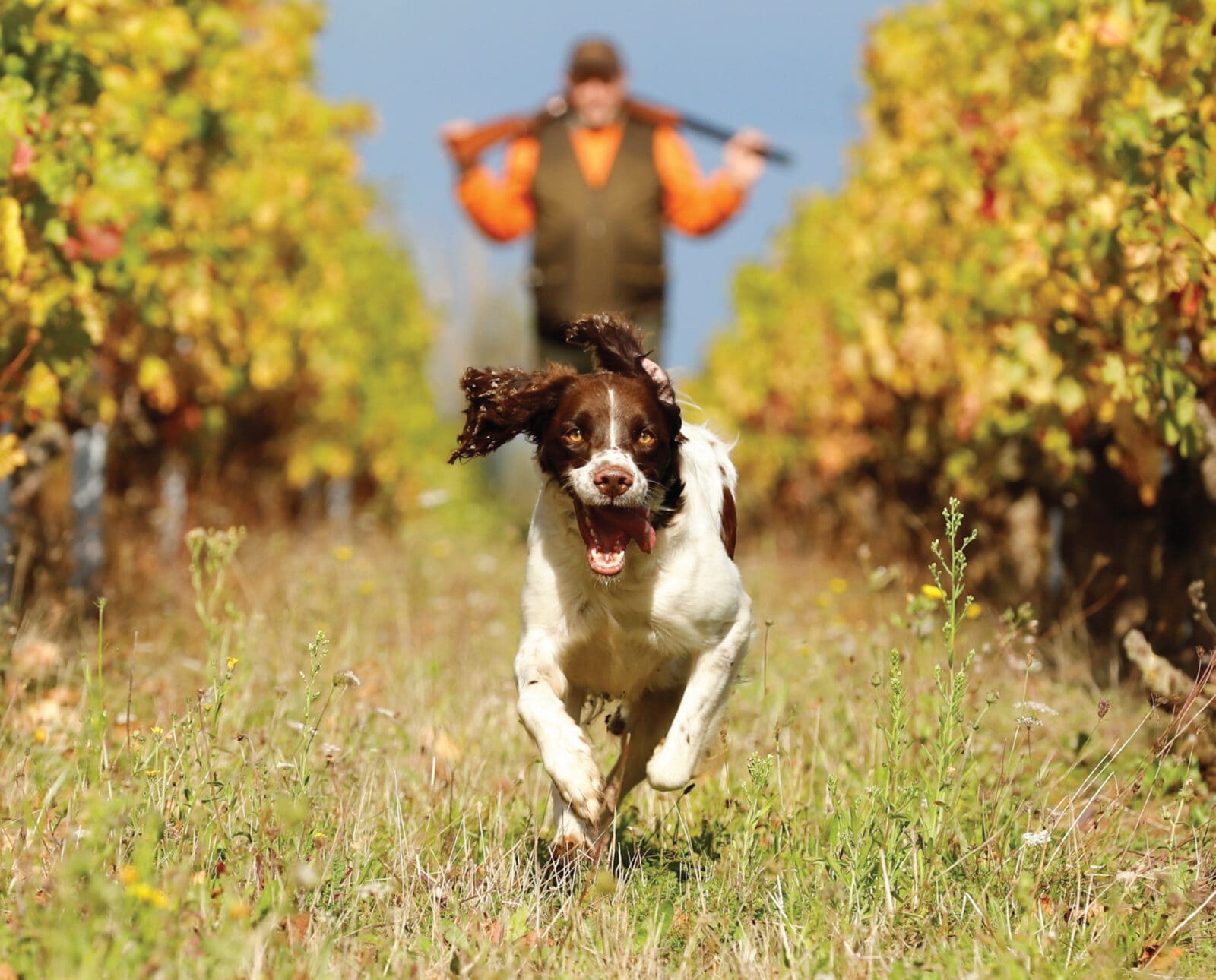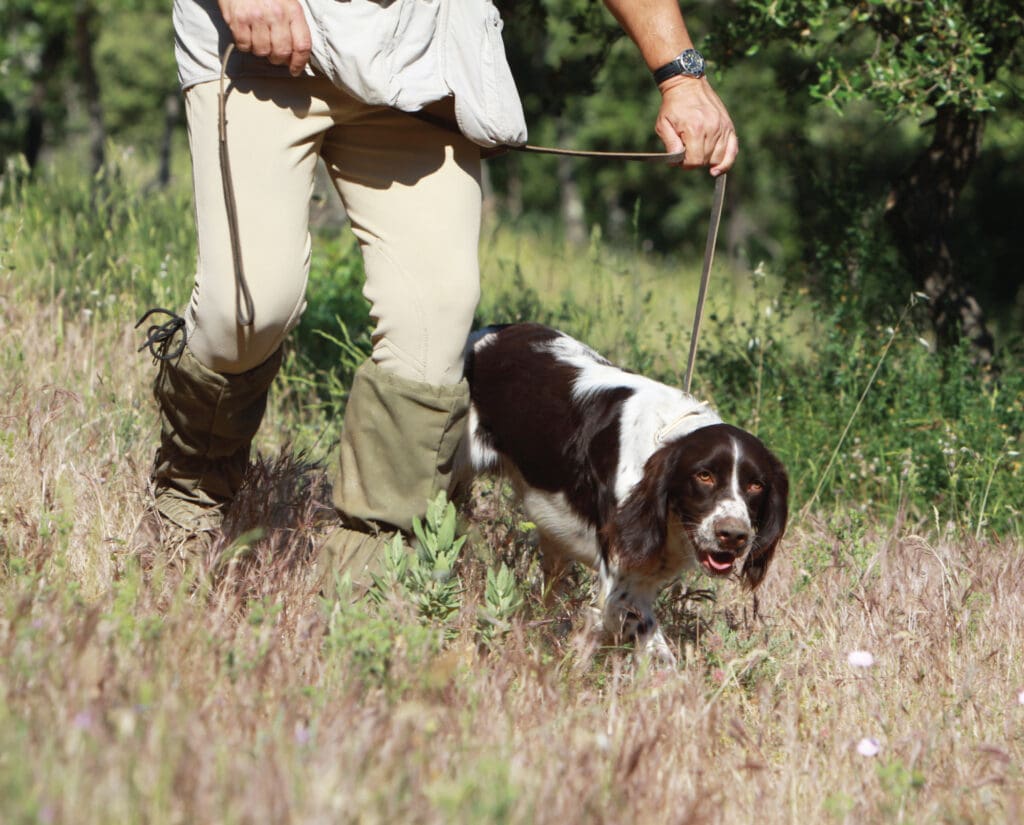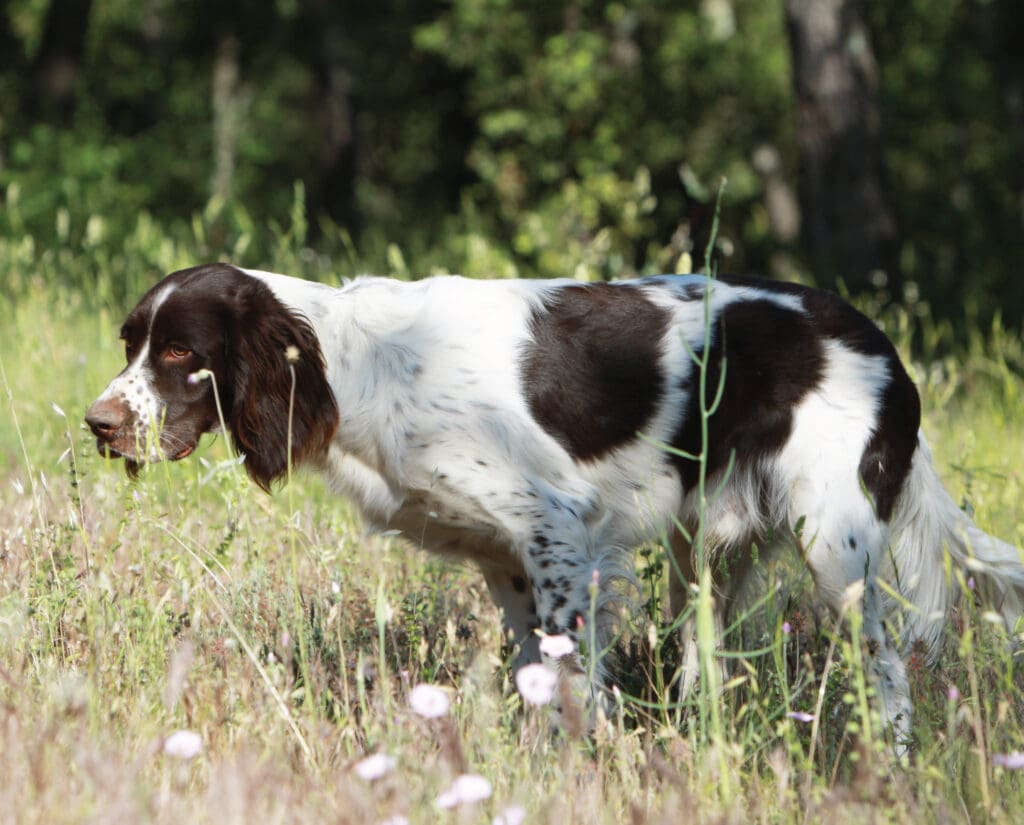Home » Hunting Dogs » French Spaniel: An Elegant, Intelligent French Pointing Breed
French Spaniel: An Elegant, Intelligent French Pointing Breed

Gabby Zaldumbide is Project Upland's Editor in Chief. Gabby was…
Characteristics, form, function, and history of the highly trainable and capable Épagneul Français
To my delight, my time spent on Duolingo, a popular language-learning application, came in handy while reading Craig Koshyk’s Pointing Dogs Volume I: The Continentals. Although I am an utter noob with hunting dogs specifically, I cherished a dog breed encyclopedia as a child. As a result, I was familiar enough with French dogs to know breeds like French Brittanies and Papillons exist. However, I had never heard of the gorgeous Épagneul Français (aye-pan-YUL fran-SAY) or French Spaniel.
Listen to more articles on Apple | Google | Spotify | Audible
“I don’t know what it is about the French Spaniel,” writes Koshyk, “but every time I try to capture that ‘special some-thing’ about the way they look and the way they move, I feel that I come up short.” It’s easy to see where Craig is coming from. His images depict gleaming, feathery-coated dogs with bright eyes, balanced features, and fluid movements. Although his photos are still, I can only imagine how visually pleasing this hard-working bird dog is when working in the field or bringing a bird to hand.
Check out pages 77 through 84 of Craig Koshyk’s first pointing dog volume to learn more about French Spaniels.
French Spaniel Characteristics and Form
| Characteristics | Details |
| Size | Medium, Males: 56-61 cm Females: 55-59 cm |
| Tail | Not docked |
| Coat | Long, requires maintenance |
| Coat Color | White and brown |
| Health issues | Ectropion and entropion, acral mutilation syndrome |
| Character | Easygoing and eager to please |
| Population | 10,000 worldwide, primarily in France and Quebec |
| Range | Close to medium, some are known to be bigger running |
| Pace | Medium gallop |
| Good Choice For | Grouse, woodcock, pheasant, snipe, partridge, rabbit, hare, and waterfowl hunting |
One of the largest spaniel breeds, French Spaniels are known for their elegant, setter-esque looks. They tend to have a certain muscularity about them, and males in particular can appear big-boned. However, they are usually longer than tall “and never square or ‘cobby’ like a Brittany,” said Koshyk.
“I think a lot of people expect a French Spaniel to be about the size of a Springer Spaniel,” Denis D’Anjou, a breeder in Quebec, said to Koshyk in a personal communication. “But the French Spaniel should be a bit taller.”
The coats of Épagneul Français are long and flat-lying. The fur along their back may have a slight wave to it. It may also be longer on the ears, back of the legs, and tail. The coat is white and brown, and shades of brown range from a light shade of cinnamon to a dark liver. Each shade may be flecked or even roan with moderate ticking. Breeders prefer their French Spaniels to have a white blaze on their head. However, all-brown heads are also acceptable.
“If I had one complaint about the French Spaniel, it would be picking burrs,” Paul Fischenich, a French Spaniel breeder in America, told Koshyk. “If you trim the Frenchy’s hair, it will grow back just like any other spaniel that gets trimmed up for hunting season. But I can’t bring myself to cut that beautiful coat.”
Their lovely coat matches their charming personality, too. “Whenever I ask breeders about the personality of their French Spaniels, one word always seems to come up more than any other: sweet,” said Koshyk. This breed is known to be easygoing and eager to please. Based on what Koshyk has seen from breeders and in the field, he’s decided that the French Spaniel strikes a balance between being a dynamic, hard-working hunter and a sweet, calm dog at home.

French Spaniel Training and Hunting Ability
Because of their excellent personality, French Spaniels are easy-to-train hunting dogs that respond well to a light touch.
“They are the most natural hunting dogs I have ever been around; the perfect dog for a novice trainer,” said Fischenich to Koshyk. “Gentle, consistent training works best.”
“So training them is pretty easy: you don’t need to resort to any force, just be patient and show them what you want them to do,” said Yves Dubois, the owner and trainer of the first French Spaniel to earn a NAVHDA VC title, said to Koshyk. Dubois continued, saying they have tons of natural ability and just need to be pointed in the right direction. “Take them hunting, and they will learn quickly. From there, you can mold them for a higher level of training,” he said.
Regarding field searching, French Spaniels move at a semi-trot and medium gallop. They should sustain a gallop through open areas and demonstrate “passion in the search” within a medium range.
“Our dogs are not bootlickers,” said Bernard Relexans, one of the most prominent French breeders, “but they are not way out there working at 300 meters either. That’s one nice thing about the breed: they like to keep in contact with the hunter…when they are in a real hunting situation, they should do whatever is necessary to find game.”
This breed also has a strong pointing dog instinct that develops early in life. If your dog is like Denis D’Anjou, it may point the very first bird it ever sees. “It may not be as intense as a setter,” he said, “and we don’t really want the same style on point, and certainly not the high tail see in North American Setters. The point should be solid but very Continental in terms of style.” Their point may even be slightly crouched. However, they should not lay down like an English Setter, according to Relexans.
Most individuals within this breed are natural retrievers. However, some are more enthusiastic about it than others. “I’d say about 80% are strong, natural retrievers. But there are some that need more encouragement and training in that regard,” said Relexans.
This ratio goes for water work, too. “They are not as natural as a Lab, of course, but with a proper introduction, they can be outstanding water dogs,” said Fischenich.
In addition to field searching, pointing, and retrieving, French Spaniels are also natural trackers. This is viewed positively in the breeding community and helps solidify the Frenchy’s title as a versatile breed. Some French Spaniels have even passed the HZP and VGP tests in Germany. “The tracking portion of NAVHDA tests is the easiest part for a French Spaniel,” said D’Anjou. “I like dogs to hold their noses fairly high, but I can tell you that when they need to track, they can be very good at it.”
French Spaniel Clubs, Tests, and Trials
France’s Club de l’Épagneul Français is the largest French Spaniel club with about 600 members. Quebec’s French Spaniel Club of Canada is smaller but very active. There’s also a club in Switzerland called the Club Suisse de l’Épagneul Français and in the Netherlands named the Nederlandse Club de Épagneul Français.
FCI, the CKC, NAVHDA, and the UKC recognize the breed.
The French parent club provides natural aptitude tests. It also sponsors annual field trials. In recent years, some dogs have even achieved field champion status. In addition to the natural aptitude tests, French Spaniels participate in other hunt tests, including the BICP and St. Hubert tests and even the CKC hunt test in North America. Two dogs have now earned NAVHDA’s VC title.

French Spaniel History
Around the 1850s, long-haired pointing dogs were common across France. They came in all shapes and sizes and could be brown and white, orange and white, black and white, even tricolored. These dogs were all lumped together in one group: les épagneuls de France. However, in the late 1800s, breed clubs decided to break “the spaniels of France” into separate breeds. The Épagneul Français was one of the first established breeds; in fact, their breed standard was first written in 1891.
Jean Castaing wrote in Les Chiens d’Arrêt, “Since it was found in every region, it could claim no regional identity, and since everyone had always known it to be brown and white with an ancient reputation for a calm and friendly nature, it was considered one of the oldest dogs of France.”
Sadly, splitting up the large group of French spaniels into individual breeds did more harm than good. It nearly wiped out all of these historic French breeds. Koshyk argues that these breed clubs should have formed a “united front” to “face the challenge presented by growing numbers of Pointers and Setters imported from the British Isles.” French Spaniels also ended up being crossed to English breeds, diluting their “pure breeding.”
Thankfully, Abbé Fournier, a French priest, decided to dedicate the rest of his life to saving the French Spaniel in 1906. He created a breeding program that saved the breed from extinction. Although he established and became the president of a new breed club with strict breeding practices, the two World Wars devastated the French Spaniel. The breed was driven to near extinction yet again.
By the end of World War II and into the 1960s, breeders grew the French Spaniel population back to sustainable numbers, and the breed was participating in shows and field trials again. In 1975, the Quebec-based breed club was formed, and the breed gained recognition from the Canadian Kennel Club in 1985.
“Today, the French Spaniel is one of the most popular native pointing breeds in France, and it is gaining the admiration of hunters in other countries,” said Koshyk.
After researching French Spaniels, they seem like a great contender for a first bird dog. Between being easy to train, great in the home, and incredible in the field, the French Spaniel checks many boxes for novice and expert uplanders alike.
“If my admiration for the breed has not been obvious enough in other sections of this chapter, let me just come right out and say it here: I like French Spaniels, and I have a great deal of admiration for the breeders and breed clubs entrusted with the safe keeping of the ancient Espaignolz from France,” said Koshyk.
Gabby Zaldumbide is Project Upland's Editor in Chief. Gabby was born in Maryland and raised in southern Wisconsin, where she also studied wildlife ecology at the University of Wisconsin-Madison. In 2018, she moved to Gunnison, Colorado to earn her master's in public land management from Western Colorado University. Gabby still lives there today and shares 11 acres with eight dogs, five horses, and three cats. She herds cows for a local rancher on the side.




French Spaniels are a well-kept secret for those of us in the USA. They are an amazing breed.